Puerto Rico << PWAIR tuh REE koh or PAWR tuh REE koh >> is an island about 1,000 miles (1,600 kilometers) southeast of Florida, the southeasternmost state in the United States. Puerto Rico forms part of the boundary between the Atlantic Ocean and the Caribbean Sea. The pleasant climate, sandy beaches, and resort hotels attract a large number of tourists from the United States mainland.
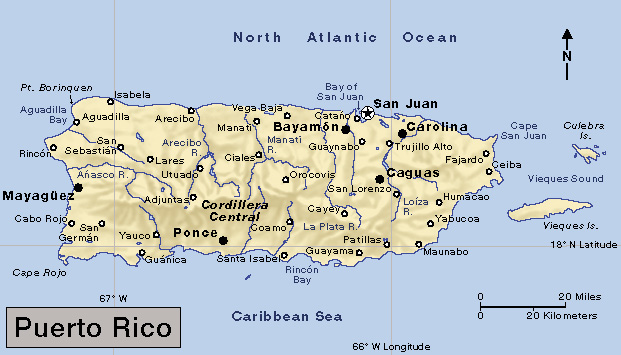
Puerto Rico is a possession of the United States, with commonwealth status. Its official name is Commonwealth of Puerto Rico. Puerto Ricans are U.S. citizens. They can move to the mainland without immigration restrictions. But when living on the island, they cannot vote in presidential elections. The commonwealth receives funds from the United States as part of an arrangement between the local and federal governments. The United States is responsible for Puerto Rico’s defense, and Puerto Ricans serve in the U.S. armed forces.
The Italian-born explorer Christopher Columbus landed on the island in 1493 during his second voyage to the New World and claimed it for Spain. He named the island San Juan Bautista (St. John the Baptist). Spain surrendered the island to the United States in 1898 at the end of the Spanish-American War.
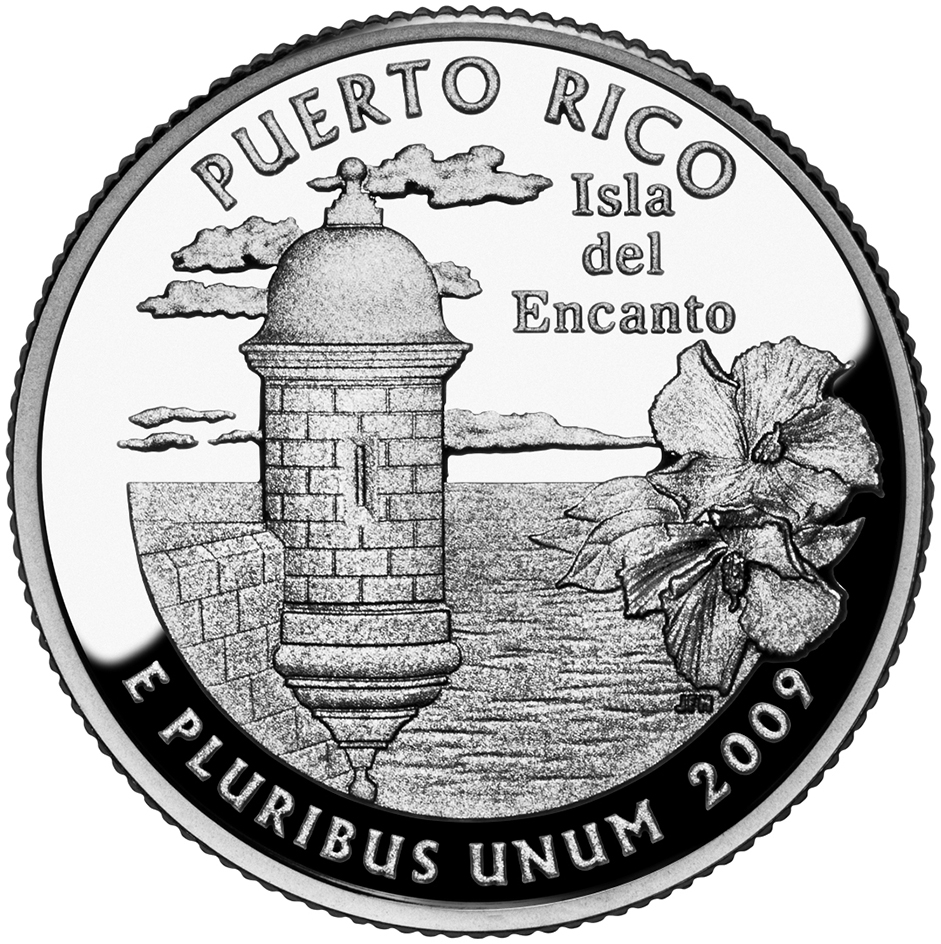
The name Puerto Rico is Spanish for rich port. In early colonial days, it was the name for San Juan, Puerto Rico’s capital and largest city. The name gradually came to be used for the entire island. The Indigenous (native) Taíno people called the island Boriken (also spelled Boriquén), meaning land of the valiant lord. Some Puerto Ricans refer to the island affectionately as Borinquen, the common spelling today. Puerto Ricans themselves are sometimes called boricuas.
Spanish is the main language and one of the two official languages of Puerto Rico. Many Puerto Ricans also speak English, the other official language. The people celebrate religious holidays with colorful festivals. Churches and forts from Spanish colonial days still stand on the island.
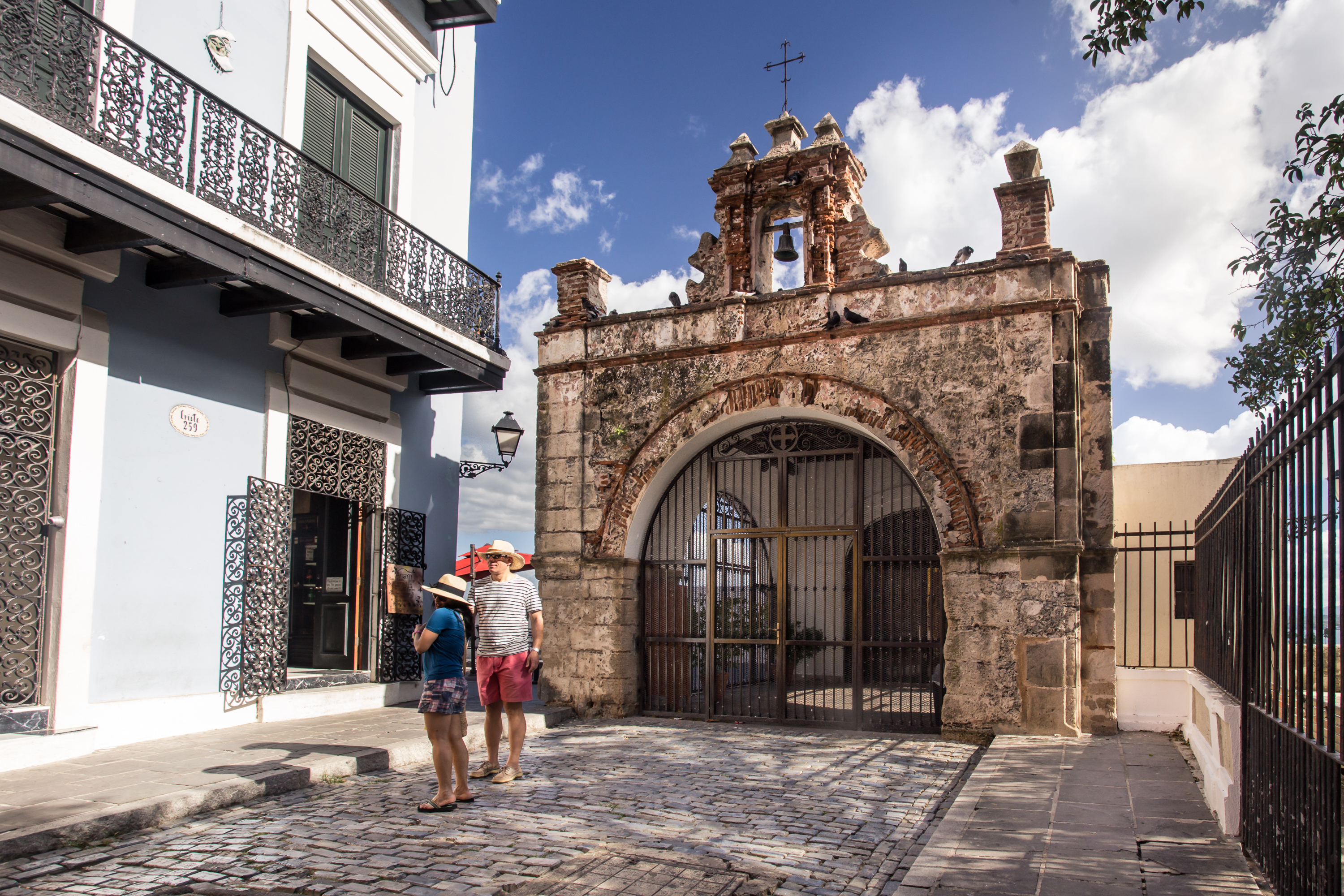
Puerto Rico also reflects its ties with the United States. The island’s large cities have freeways, housing projects, and shopping centers like those in many cities on the U.S. mainland.
Government
In 1947, the United States Congress gave Puerto Rico, a U.S. possession, the right to elect its own governor. In 1952, Puerto Rico became a commonwealth of the United States. 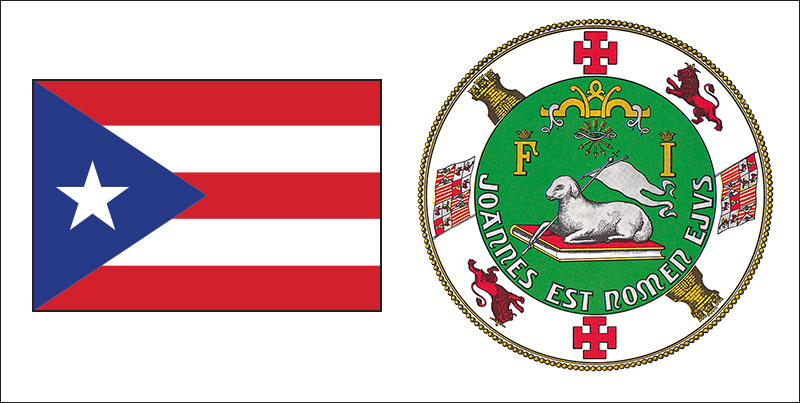
The U.S. Congress is responsible for governing Puerto Rico, but the island exercises self-government in all local affairs. The commonwealth government operates under its own Constitution, adopted in 1952. Most federal laws apply to Puerto Rico as though it were a state. A resident commissioner, elected to a four-year term, represents Puerto Rico in the U.S. Congress. The resident commissioner may vote in committees of the U.S. House of Representatives. But unlike representatives from the states, the commissioner may not vote on final legislation in the House.
Since 1967, Puerto Rico has held several plebiscites (popular votes) on whether it should remain a commonwealth or pursue a different political status, such as U.S. statehood or independence. Such votes have had various results, but none have led to a change in status yet. Any change to Puerto Rico’s status would require approval by the U.S. Congress.
The governor
is the chief executive officer of Puerto Rico and appoints other top executive officials. The governor is elected to a four-year term.
The legislature
of Puerto Rico consists of a Senate and a House of Representatives. Members of both houses are elected to serve four-year terms. The legislature consists of at least 27 senators and 51 representatives.
During years in which a general election is held, the legislature meets for a single regular session that lasts from January to June. In all other years, the legislature meets for a second general session that lasts from August to November. The governor may call special sessions at any time.
Courts.
The Supreme Court of Puerto Rico is the highest court in the commonwealth. It has nine justices appointed by the governor. The justices may serve until they reach the retirement age of 70. The Court of Appeals consists of 39 judges, each of whom is appointed by the governor to a 16-year term. Puerto Rico’s superior court judges are appointed to 12-year terms. The municipal judges are appointed to 8-year terms. Cases involving federal law are heard in the U.S. District Court for Puerto Rico, which has seven judges appointed by the U.S. president.
Local government.
Puerto Rico’s basic unit of local government is the municipio (municipality). The commonwealth is divided into 78 municipalities. The voters in each municipality elect a mayor and an assembly. The mayor appoints a secretary-auditor and a treasurer.
Politics.
Registered political parties receive financial aid from a government fund. Puerto Rico’s leading parties are the New Progressive Party (PNP), which favors U.S. statehood for Puerto Rico; and the Popular Democratic Party (PPD), which favors the island’s current commonwealth status. A third party is the Independence Party (PIP), which favors independence for the island.
People
Population and ancestry.
Puerto Rico has a high population density of about 920 persons per square mile (355 per square kilometer), which is greater than the density of any U.S. state. The 2020 United States census reported that Puerto Rico had 3,285,874 people. The island’s population had decreased 12 percent from the 2010 figure, 3,725,789.
Loading the player...Puerto Rico commonwealth anthem
The Jones Act of 1917 made Puerto Ricans U.S. citizens. Since then, and because of economic and social conditions on the island, many Puerto Ricans have settled in he U.S. states, particularly California, Connecticut, Florida, Illinois, Massachusetts, New Jersey, New York, and Pennsylvania. Puerto Ricans on the mainland commonly are called the diaspora.
Over 95 percent of all Puerto Ricans on the island live within the metropolitan areas of Aguadilla, Arecibo, Guayama, Mayagüez, Ponce, and San Juan-Bayamón-Caguas.
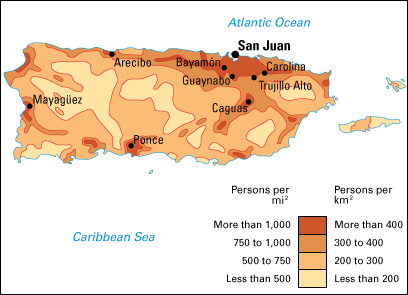
San Juan, Puerto Rico’s capital and largest city, is a seaport on the north coast. The San Juan-Bayamón-Caguas metropolitan area includes Bayamón and Carolina, the next largest cities. Ponce, the fourth largest city, is a commercial and cultural center on the south coast. Other major cities of Puerto Rico include Arecibo, Fajardo, Mayagüez, and Trujillo Alto.

The Taíno people lived in Puerto Rico when the Spaniards first arrived. Most of them were killed or died of disease after the Spanish settlers came. Beginning in 1510, Black people were brought from Africa to Puerto Rico to work on plantations and in small gold mines. Some European settlers had children with the Indigenous people and Africans. Today, Puerto Ricans have a mixed racial and cultural heritage that includes European Spanish, Taíno, and African ancestors. No Indigenous people of unmixed ancestry are known to live in Puerto Rico.
Artifacts from Taíno and African cultures can be found in many of the island’s historical sites and museums, and the influence of these cultures appears in its art, food, and music. For example, bomba is a style of percussive music and dance with roots in African culture.

Way of life.
Puerto Ricans have experienced a great change from a rural to an industrial lifestyle, particularly since about the 1950’s. Older generations remember what it was like to live in houses with dirt floors. Younger generations are familiar with a more industrial, commercial society that includes such elements as busy highways and shopping malls.
Traditional Puerto Rican culture usually is idealized as celebrating rural practices and nature. The jibaro (peasant), with a straw hat, simple clothing, and knowledge of the land, still is seen as a hero or ideal of Puerto Rican life. Folk art and music celebrate the lifestyle and quiet dignity of the jibaro as simple and generous. Some Puerto Ricans view the rural ideal as too unsophisticated. At the same time, many Puerto Ricans treasure the island’s natural beauty and show concern about its conservation.
Puerto Rican culture maintains a great respect for elders and family members. A lot of Puerto Ricans come from close-knit families, and their extended families remain important to them throughout their lives. It is common for Puerto Ricans to spend some years living in the U.S. states, then return to live on the island later in life. About 85 percent of the people are Roman Catholics. Most of the rest are Protestants.
Puerto Rican food is rich in locally produced ingredients, including beans, coffee, fresh fruit, and plantains (a type of banana). Distinctive dishes include the pastel and mofongo. The pastel is a filling of plantain and root vegetables wrapped in a plantain leaf. Mofongo, which reflects African influence, is a mixture of ground plantain; garlic; and fried pig skin, also called pork cracklings. Islanders and visitors enjoy such recreational activities as hiking, surfing, and swimming.
Education
The majority of Puerto Rico’s students attend public schools. Soon after Puerto Rico became a U.S. territory in 1898, the U.S. government set up the territory’s public school system. Public schools in Puerto Rico are organized under the Department of Education (Departamento de Educación de Puerto Rico). A secretary of education, appointed by the governor, heads the department.
Spanish is the main language used in schools in Puerto Rico, but students are also taught English. School attendance is compulsory for children from ages 5 to 18. The schools are divided into three levels: primary (grades 1 through 6), secondary (grades 7 through 12), and postsecondary.
Puerto Rico has a umber of colleges and universities. The University of Puerto Rico (Universidad de Puerto Rico), founded in 1903, is the oldest institution of higher learning on the island.
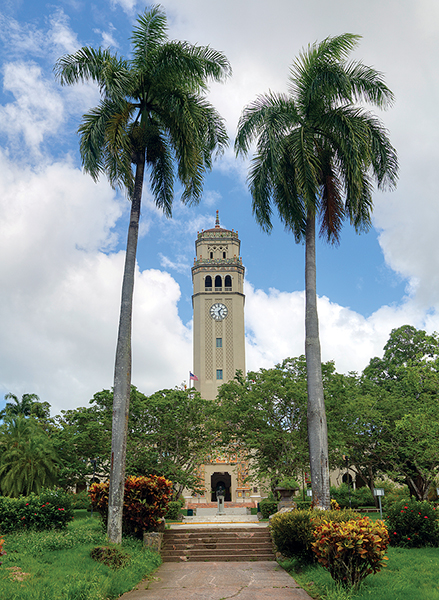
Many Puerto Ricans attend universities in the U.S. states. Members of the diaspora have been influential in founding Puerto Rican studies programs at several postsecondary institutions in the states, particularly in the Northeast.
Visitor’s guide
Beaches surround Puerto Rico’s interior of rugged mountain ranges and rolling hills. The island offers a variety of water sports. Many visitors enjoy the historic buildings and colorful shops in the older part of San Juan, called Old San Juan, and in the island’s cultural center, Ponce. United States citizens do not need passports to travel to Puerto Rico.
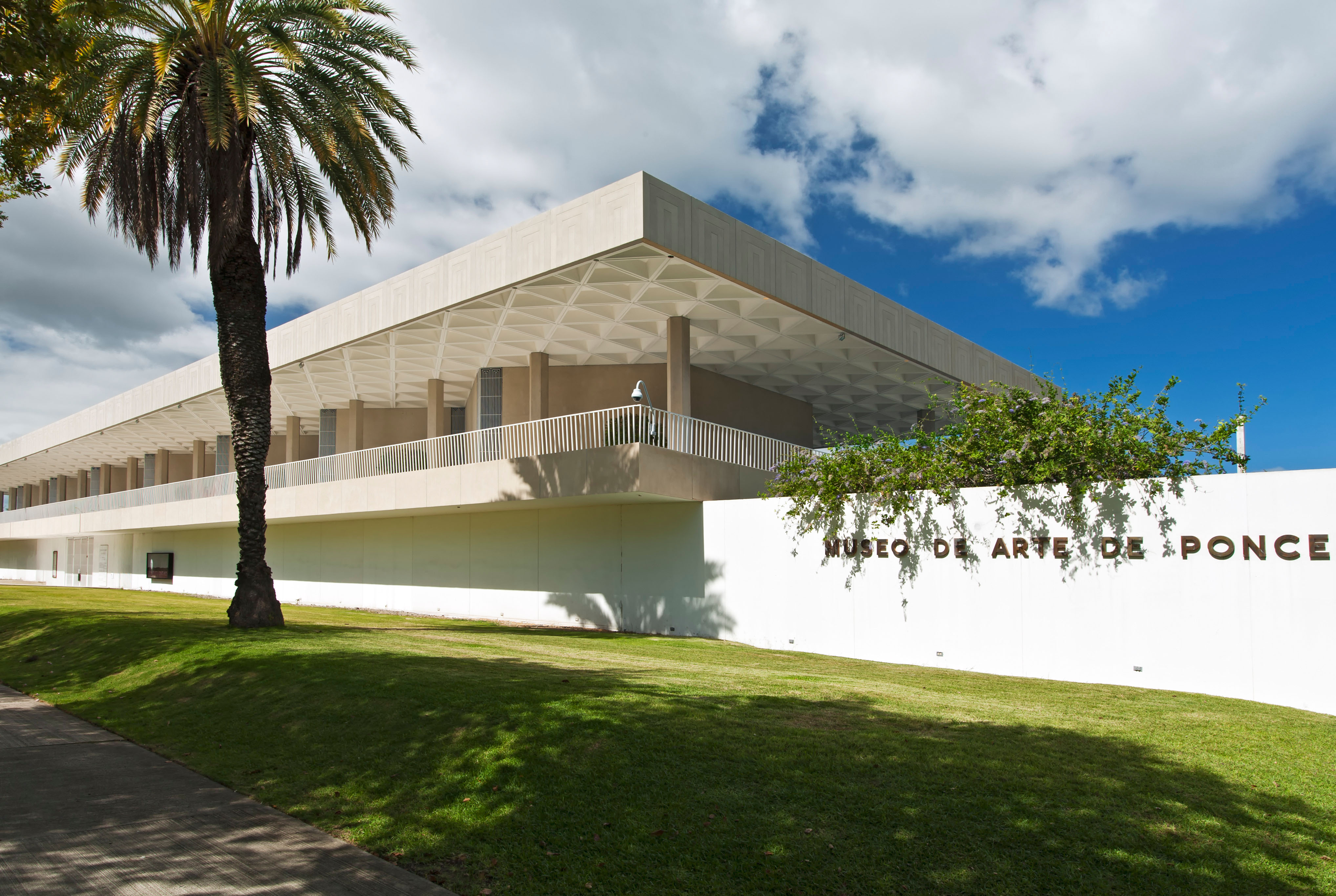
The land
Puerto Rico is one of the largest islands that lie between Florida and South America. It covers 3,425 square miles (8,870 square kilometers). The commonwealth as a whole includes many smaller islands. The largest, in order of size, are Vieques, Mona, and Culebra.
Land regions.
The island of Puerto Rico has four main land regions. They are (1) the Coastal Lowlands, (2) the Coastal Valleys, (3) the Foothills, and (4) the Central Mountains.
The Coastal Lowlands
border the coast on the north and the south. The northern lowlands are about 8 to 12 miles (13 to 19 kilometers) wide. Their climate is generally humid.
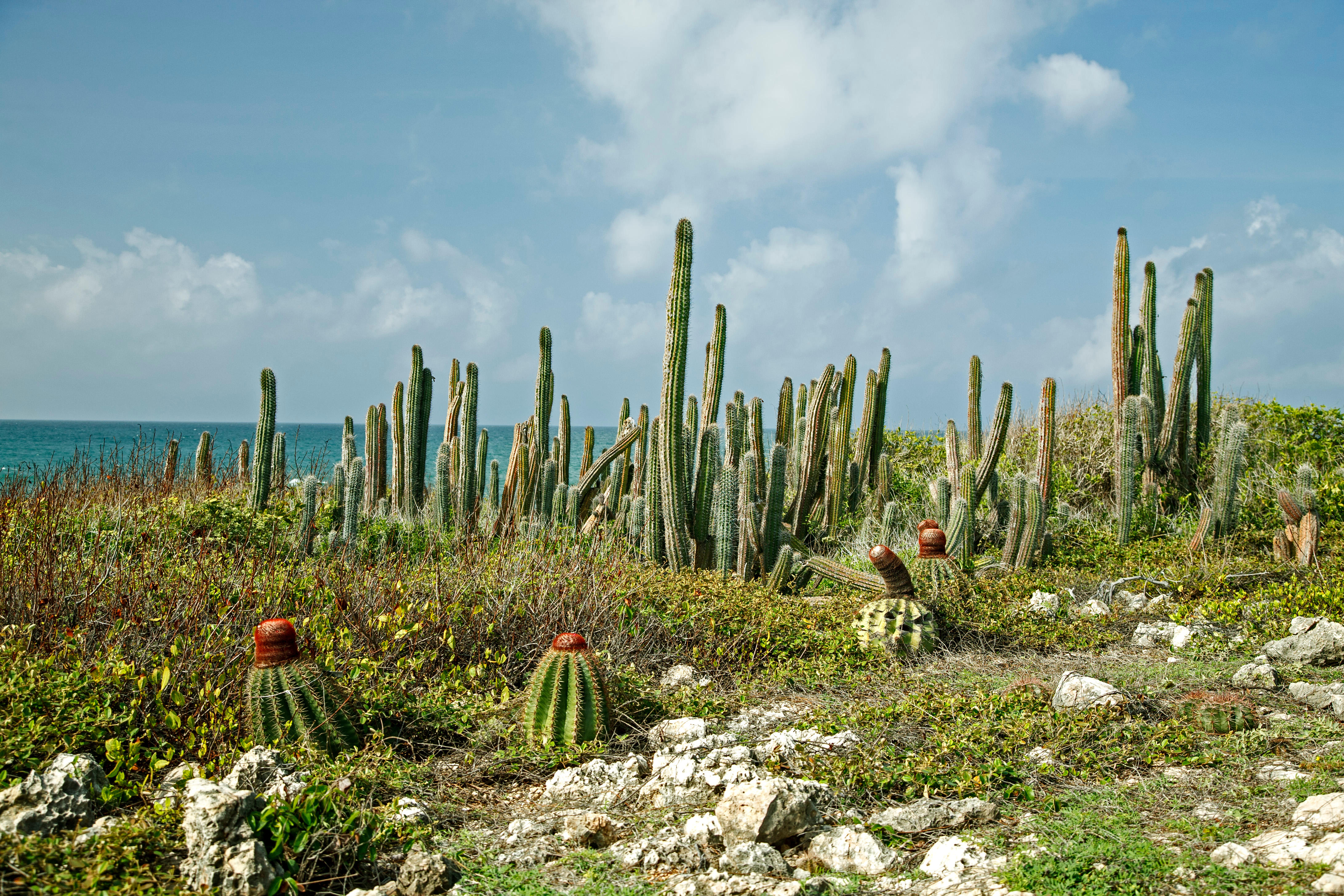
The southern lowlands cover a narrower area and have a much drier climate. Most of Puerto Rico’s industry and its largest cities, San Juan, Bayamón, Ponce, and Carolina, are in the lowlands.
The Coastal Valleys
extend inland from the coast on the east and the west. Most of the land in these valleys is used for growing sugar cane. Coconuts and other fruits also grow in these areas. 
The Foothills
rise in two long east-west chains, just inland from the northern and southern coastal lowlands. Much of the area has jagged peaks and round basins. The basins formed when water wore away the limestone under the hills, and the ground sank.
The Central Mountains
run east and west across the south-central part of the island. The main range is the Cordillera Central. The highest peak in Puerto Rico, Cerro de Punta, rises 4,389 feet (1,338 meters) in the Cordillera Central. This mountain region also contains many fertile valleys in which farmers raise crops. Coffee is the main crop of the western part of the region. Citrus fruits are also grown in the mountain valleys.
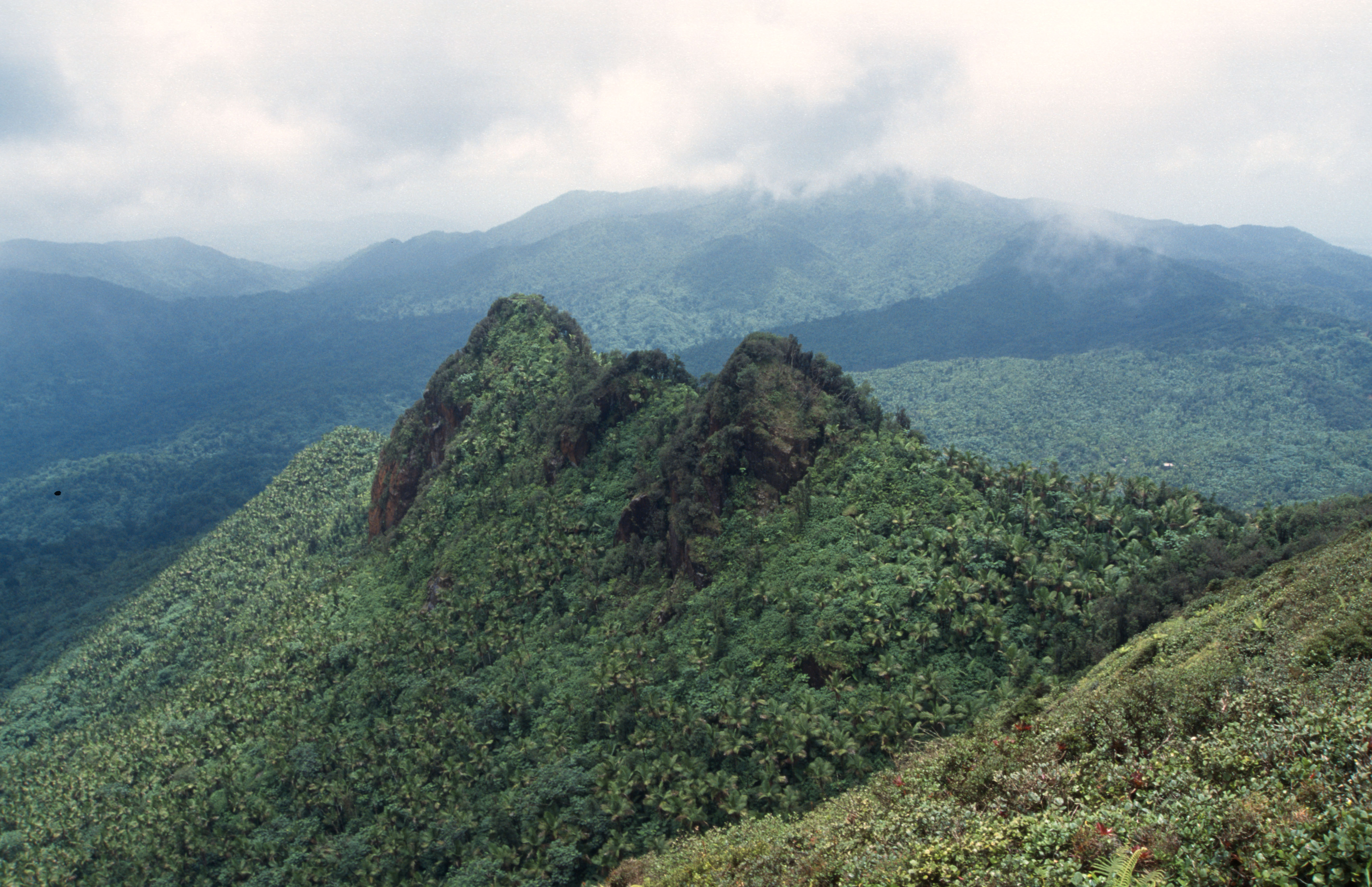
Coastline.
Puerto Rico’s general coastline measures 311 miles (501 kilometers). The tidal shoreline, which includes small bays and inlets, is about 700 miles (1,127 kilometers) long. The island has many beaches and harbors.
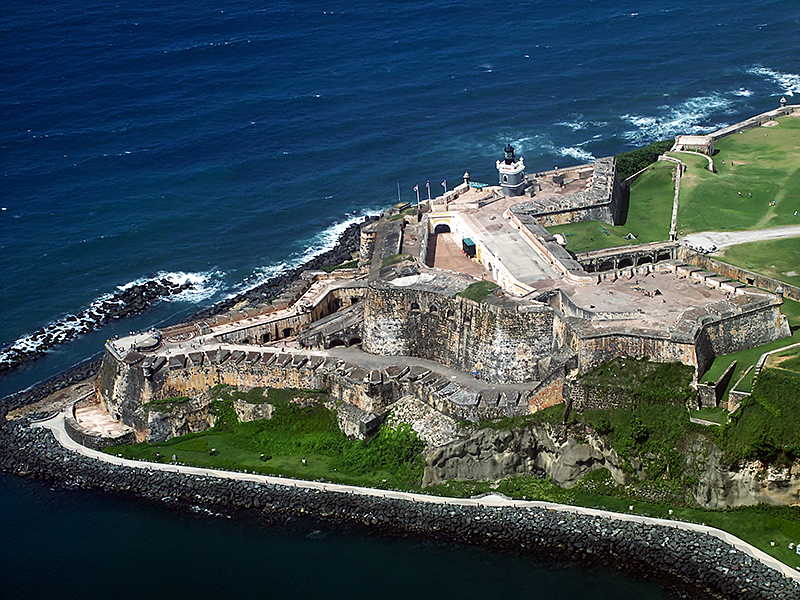
Rivers.
Puerto Rico’s longest rivers, such as the Arecibo, La Plata, and Loiza, flow northward from the mountains into the Atlantic Ocean. None of the rivers is suitable for large boats. But they are important sources of water for hydroelectric power, industries, and irrigation.
Plant and animal life.
Much of the tropical forest that formerly covered Puerto Rico was cleared to create farmland or for commercial, housing, and industrial development. Many of the remaining trees are valued for their beauty. These include the flamboyan (poinciana), with brilliant red, orange, and yellow blossoms; the African tulip; and the huge ceiba (kapok). Some trees bear delicious fruits and nuts that are little known elsewhere in the United States. Among these are breadfruit, guanabanas, papayas, sea grapes, and star apples.
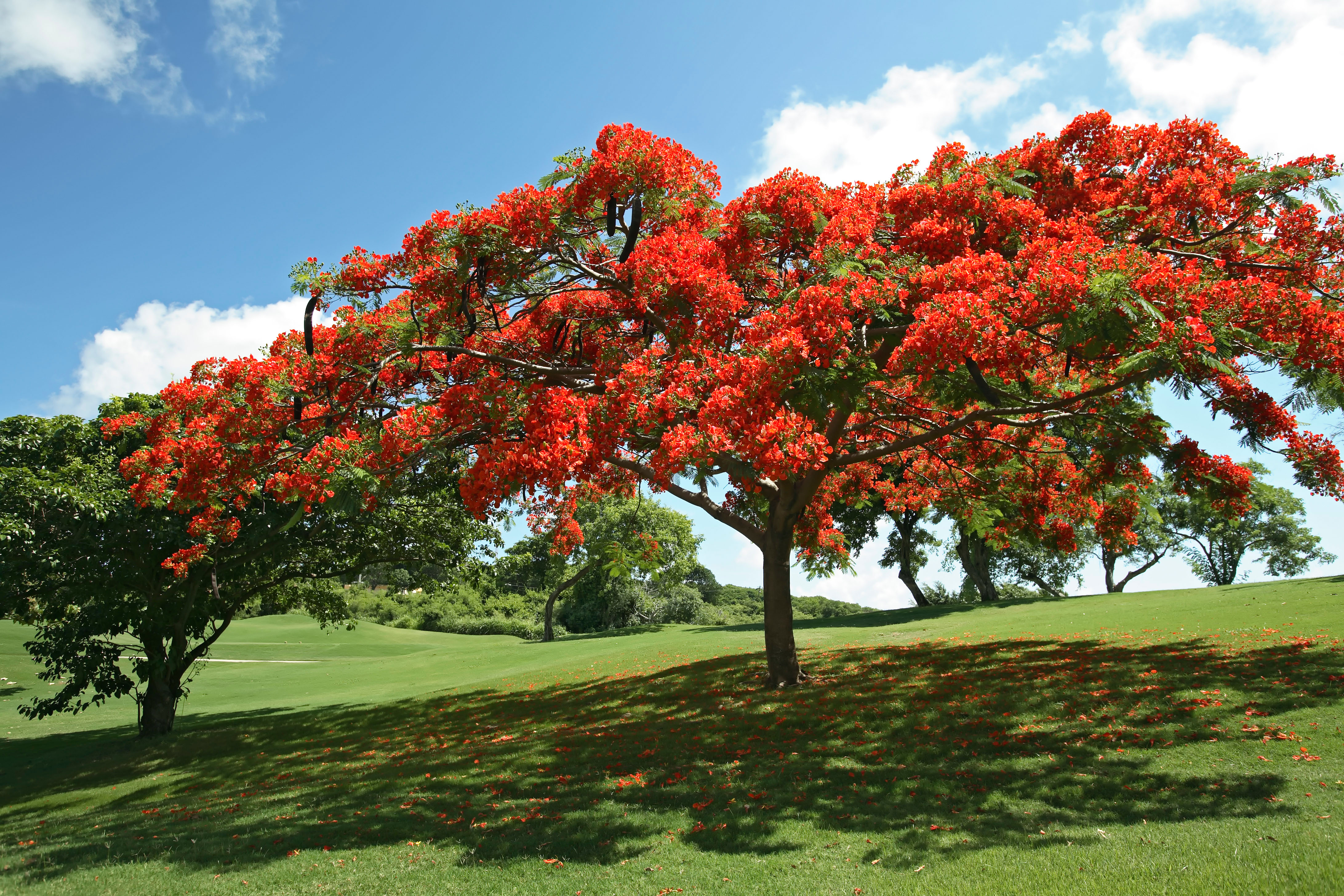
Many beautiful flowers grow on the island. They include orchids and poinsettias.
Puerto Rico has few wild animals. Bats and mongooses are found on the island. Puerto Rico has few snakes of any kind and no poisonous ones. However, it has iguanas and other lizards. It also has many kinds of birds. The coquí, a small frog, sounds a clear, musical note during the evening hours. The island’s many insects include the cucubano, a large tropical relative of the common firefly. Some insects, such as mole crickets and termites, may damage buildings and crops. The Puerto Rico Paso Fino Horse, known for its elegant, smooth gait, is bred on the island. 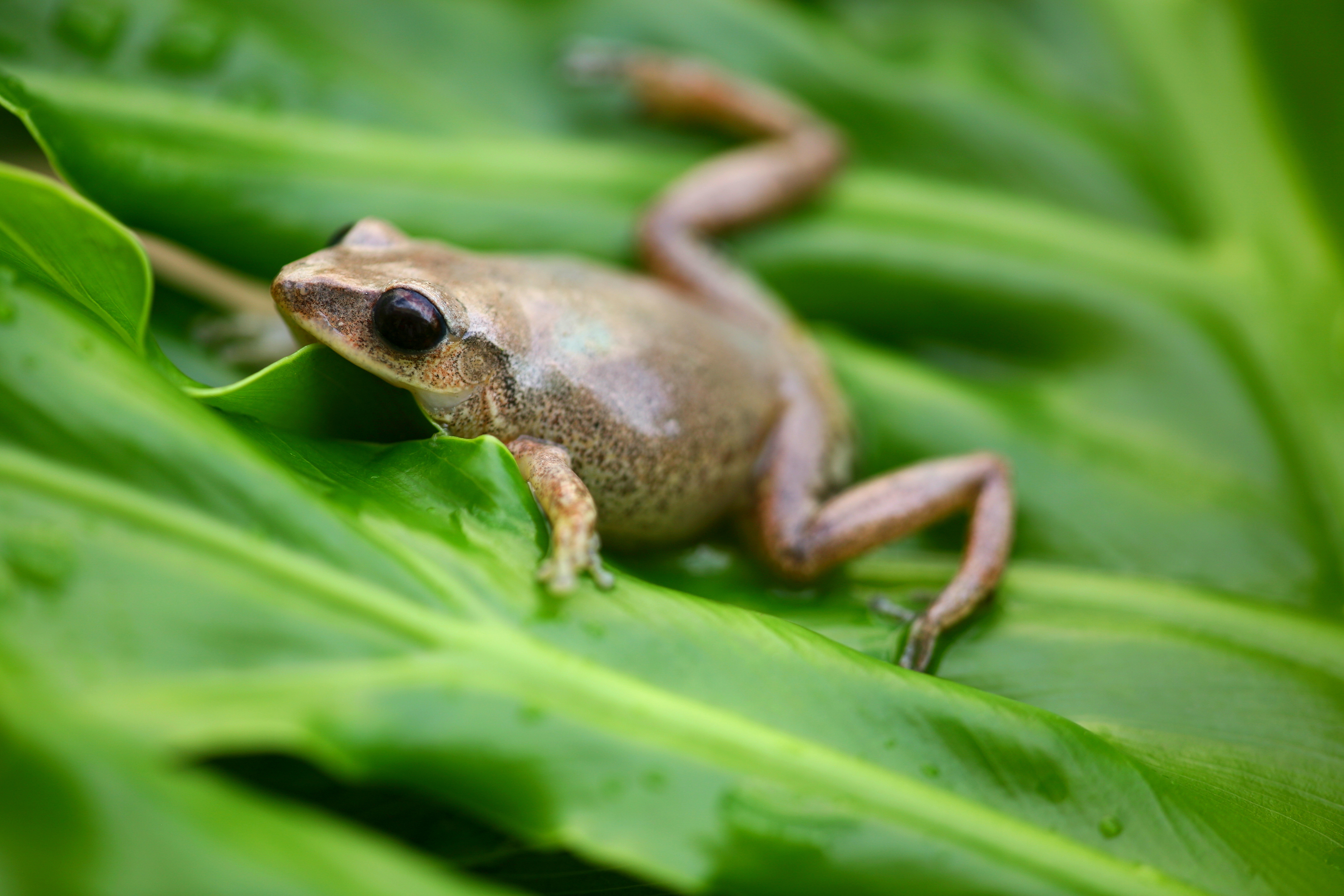
Fishes in the ocean around Puerto Rico include barracuda, herring, marlin, mullet, pompano, sharks, snappers, Spanish mackerel, and tuna. Lobsters and oysters are also caught in Puerto Rican waters.
Climate
Puerto Rico’s pleasant climate makes the island a popular vacation spot. The climate also provides good conditions for growing crops. Temperatures average about 73 °F (23 °C) in January and 80 °F (27 °C) in July. Frost and snow never occur, and even hail is rare. Sea breezes make the climate much more comfortable in summer than it is in the central United States.

Puerto Rico receives rainfall throughout the year. The wettest season occurs from May to October. Rainfall is usually heavy, but it lasts a short time. The drier sections of the southern coast average 37 inches (94 centimeters) of rain a year. Rainfall in the north averages 70 inches (180 centimeters) a year. A rain forest on El Yunque, a mountain, sometimes gets over 200 inches (510 centimeters) a year.
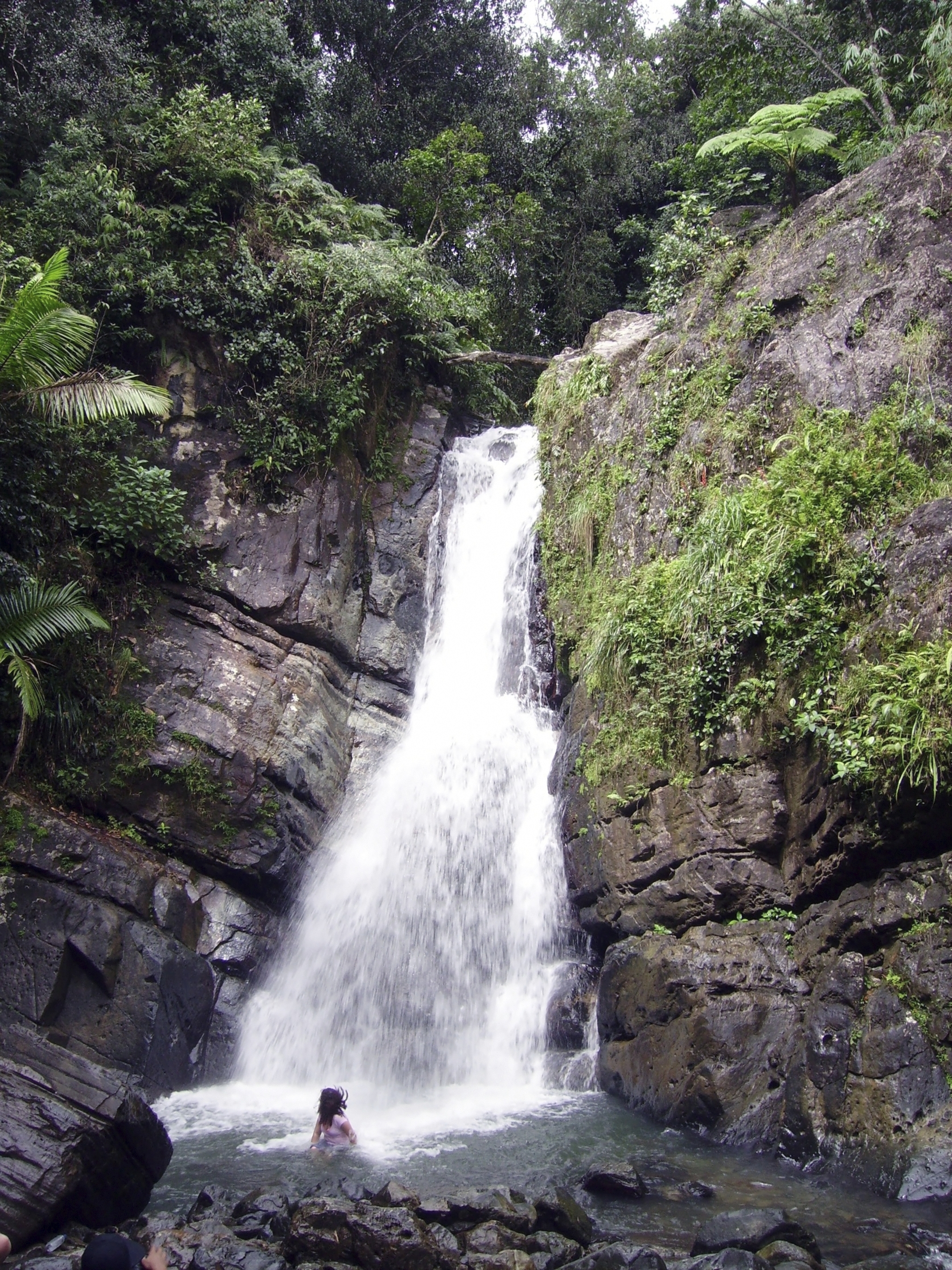
People in Puerto Rico must be alert for hurricanes from June through November. But severe hurricanes occur on the average of only once every 10 years. The U.S. National Weather Service predicts these storms hours or even days in advance. Reports in newspapers and on the radio, television, and the Internet warn people of the approach of a storm so they have time to take shelter in strong buildings.
The highest temperature ever recorded in Puerto Rico, 103 °F (39 °C), occurred at San Lorenzo on Aug. 22, 1906. The lowest temperature, 40 °F (4 °C), was recorded at Aibonito on March 9, 1911.
Economy
Manufacturing is the single most valuable industry in Puerto Rico. It provides a larger portion of the gross domestic product (GDP) than any other economic activity. Gross domestic product is the total value of all goods and services produced within a region in a year. The service industries, taken together, supply about half of the gross domestic product of Puerto Rico. Many American businesses from the states also are found in Puerto Rico.
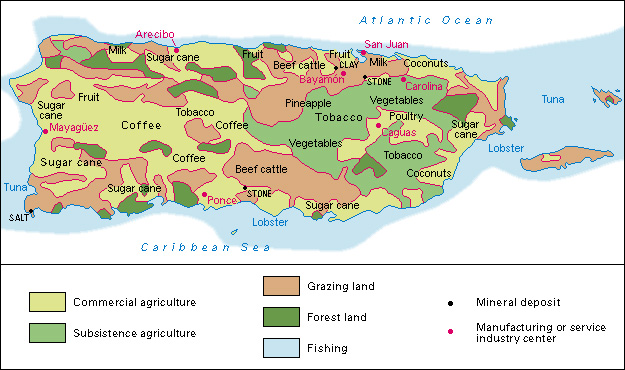
Millions of tourists visit Puerto Rico every year. Most of them come from the U.S. mainland. Tourist activities benefit many parts of Puerto Rico’s economy, especially such services as the operation of hotels and restaurants.
Natural resources.
One of Puerto Rico’s most important natural resources is its climate. The year-round balmy weather not only attracts many tourists but also helps make Puerto Rico a desirable location for industries. The warm, moist climate also allows Puerto Ricans to grow tropical crops.
Soil
is an important resource in Puerto Rico. The island has hundreds of types of soil. Soil erosion is a serious problem on the island, but it is being reduced by soil conservation methods. For example, some farmers use contour planting, a conservation method that involves planting horizontally along the curve of a hill to reduce erosion.
Minerals.
Clay, lime, portland cement, salt, sand and gravel, and stone account for almost all of Puerto Rico’s mine production. Spanish settlers washed gold out of Puerto Rican streams, but the gold supply was soon used up. Small deposits of cobalt and nickel and two large copper deposits have been found on the island. Salt is made from seawater.
Service industries,
taken together, make up about half of the gross domestic product of Puerto Rico. Most of the service industries are concentrated in the metropolitan areas.
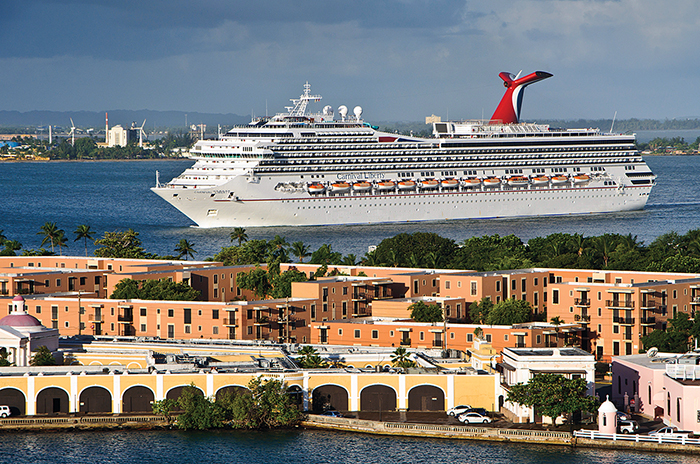
Finance, insurance, and real estate make up the leading service industry group in Puerto Rico in terms of contributions to the gross domestic product. San Juan, the chief financial center, is home to hundreds of banks and other financial organizations.
Wholesale and retail trade is another important service industry group. The wholesale trade of groceries, motor vehicles, petroleum and petroleum products, and pharmaceuticals (medicinal drugs) is especially important. San Juan, Bayamón, Carolina, and Guaynabo are the leading centers of wholesale trade. Puerto Rico’s retail trade is aided by the tourists who visit Puerto Rico.

Taken together, (1) community, business, and personal services and (2) government services employ about half of all Puerto Ricans. Community, business, and personal services include private health care and tourism. Government services include military activities and the operation of public schools and hospitals.
Manufacturing
accounts for much of Puerto Rico’s gross domestic product. Most of Puerto Rico’s manufacturing occurs in the north-central part of the island. Factories in Puerto Rico manufacture and process a great variety of products. Leading manufactured products include chemicals, especially pharmaceuticals; computer and electronic products; electrical equipment; fabricated metals; food and beverage products; machinery; and medical equipment and supplies. Other important manufactured products include cement and concrete products, clothing, printed materials, and rubber and plastic products.

Agriculture.
About 20 percent of Puerto Rico’s total land area is used for farming. Much fertilizer must be used to enrich the fields, because the land has been worked hard for hundreds of years. Irrigation provides water for farms in the drier southern parts of the island. Irrigation is also used on farms along the northwest coast of Puerto Rico.
Milk is Puerto Rico’s most valuable livestock products. Beef cattle, eggs, pork, and poultry are also important. Puerto Rico has rapidly increased its production of livestock to help feed its growing city populations.
Coffee is a leading crop in Puerto Rico. Coffee beans are grown in the western part of the central mountains.
Bananas and plantains are among Puerto Rico’s most important commercial fruits. They are grown chiefly in the central mountains area. Pineapples are grown in the coastal lowlands. Other fruits grown in Puerto Rico include avocados, coconuts, and oranges and other citrus fruits.
Mining.
Stone ranks as Puerto Rico’s most valuable mined product. Other mined products include clay, lime, portland cement, salt, and sand and gravel.
Fishing industry.
Fishing is a minor sector in Puerto Rico’s economy. About 3 million pounds (1.5 million kilograms) of fish and shellfish are caught yearly.
Trade
between Puerto Rico and the states is governed by the same laws and regulations as trade among the U.S. states themselves. Puerto Ricans do not pay customs duties on goods imported from the states, as they do on imports from other countries. The U.S. states together are Puerto Rico’s leading trade partner. The commonwealth exports more goods than it imports.
In the past, Puerto Rico’s most important exports were molasses, rum, and sugar. Of these, only rum is still exported in large quantities. Today, Puerto Rico also exports computer and electronic products, electrical equipment, food products, machinery, medical equipment and supplies, pharmaceuticals, and primary metals. Puerto Rico’s chief imports are chemicals, computers and electrical products, food products, machinery, petroleum products, pharmaceuticals, and transportation equipment.
San Juan, Ponce, and Mayagüez have foreign trade zones. In such zones, firms can process, store, and reship their goods without paying customs duties.
Electric power and utilities.
Puerto Rico’s utilities provide electric, gas, and water service. Electric power is produced and sold by the Puerto Rico Electric Power Authority, a government corporation created in 1941. Electric power is produced chiefly by power plants that burn petroleum or natural gas.
Transportation.
Puerto Rico has about 17,000 miles (27,000 kilometers) of surfaced roads. These roads provide good transportation by automobile, bus, and truck throughout the island. A commuter railway known as the Tren Urbano (Urban Train) connects San Juan to a number of suburbs.
Puerto Rico’s chief seaports include San Juan in the north, Ponce in the south, and Mayagüez in the west. The largest airport is Luis Muñoz Marín International Airport in San Juan.
Communication.
Puerto Rico’s first newspaper, El Día (The Day), was founded at Ponce in 1909. Today, Puerto Rico’s newspapers include El Nuevo Día (The New Day), El Vocero (The Spokesperson), and the English-language The Puerto Rico Daily Sun, all of which are published in the San Juan area.
Puerto Rico’s first radio station, WKAQ, began broadcasting from San Juan in 1922. WKAQ built Puerto Rico’s first television station in 1954 in San Juan. Today, Puerto Rico has numerous radio and TV stations. Many of the island’s households receive cable television service. Most cable programming is in English. Cell phone and Internet usage has increased rapidly since the beginning of the 2000’s.
History
Spanish rule.
Christopher Columbus sailed to Puerto Rico in 1493 on his second voyage to the Western Hemisphere. Spaniards, led by Juan Ponce de León, began the first European settlement on the island in 1508. Ponce de León became the first governor in 1509. The Taíno people who lived there rose against the settlers, but all the revolts failed. By the mid-1500’s, most of the Taíno had been killed or enslaved, or had died of disease.
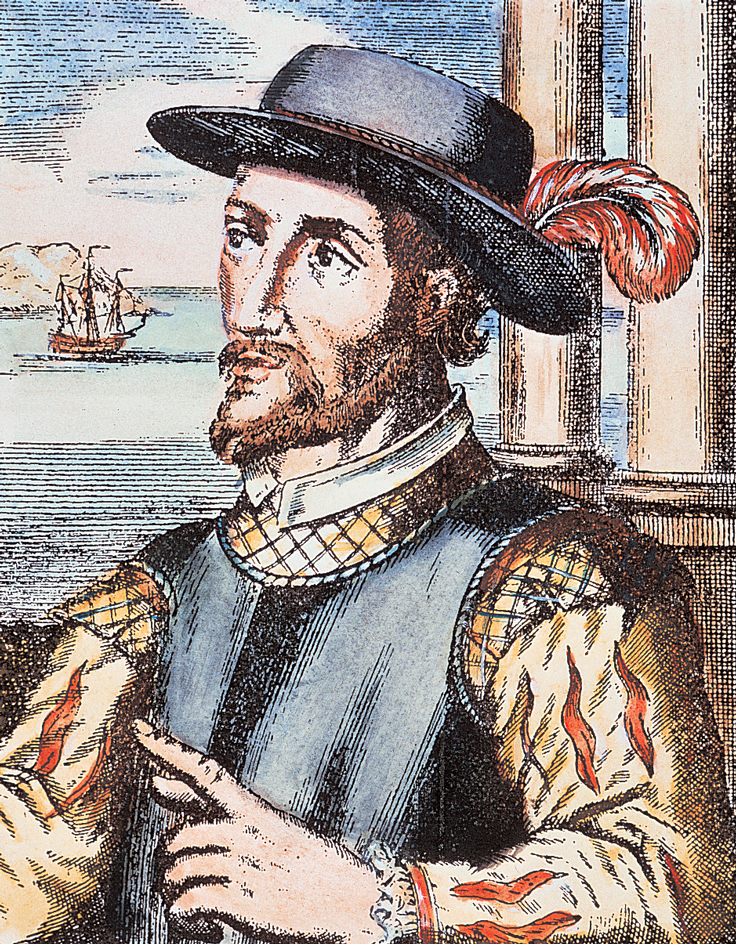
The island colony suffered for hundreds of years from hurricanes and plagues. It was attacked by the Carib people, who lived on nearby islands, and by the Dutch, English, and French. Still, the Spanish population slowly grew, fortifications and towns were built, and agriculture increased. After about 1850, the desire for greater freedom from Spain increased among the people of Puerto Rico. In 1897, Spain provided for a large amount of local rule. A new Puerto Rican government was set up in 1898 shortly before the beginning of the Spanish-American War.
United States rule.
On July 25, 1898, U.S. forces began to land in Puerto Rico after bombarding San Juan. Spain surrendered Puerto Rico to the United States in the Treaty of Paris, which was signed on Dec. 10, 1898.
Under the temporary U.S. military government, the use of U.S. money and postage stamps on the island was made official. The first U.S. civil governor was appointed by President William McKinley under the terms of the Organic Act of 1900, also known as the Foraker Act.
The United States built dams, hospitals, roads, and schools. But the economy depended on agriculture, and U.S. firms owned and received much of the profits from the best plantations and largest sugar mills.
In 1917, the second Organic Act, or Jones Act, gave U.S. citizenship to Puerto Ricans. The island contributed troops to the U.S. armed forces during World War I (1914-1918) and World War II (1939-1945). During the Korean War (1950-1953), the U.S. Army’s 65th Infantry Regiment, made up of Puerto Ricans, won fame for its courage and daring. Puerto Rican soldiers also participated in the Vietnam War (1957-1975), the Persian Gulf War of 1991, the Afghanistan War (2001-2021), and the Iraq War (2003-2011).
Building a democracy.
In the early 1940’s, Puerto Rican leaders, with aid from the United States government, began a program to improve living conditions on the island. The program became known as Operation Bootstrap. Large farms were broken up, and land was redistributed among farmworkers. An improved educational program rapidly reduced the number of Puerto Ricans who could not read and write. Thousands of old slum dwellings were torn down and replaced by modern housing.
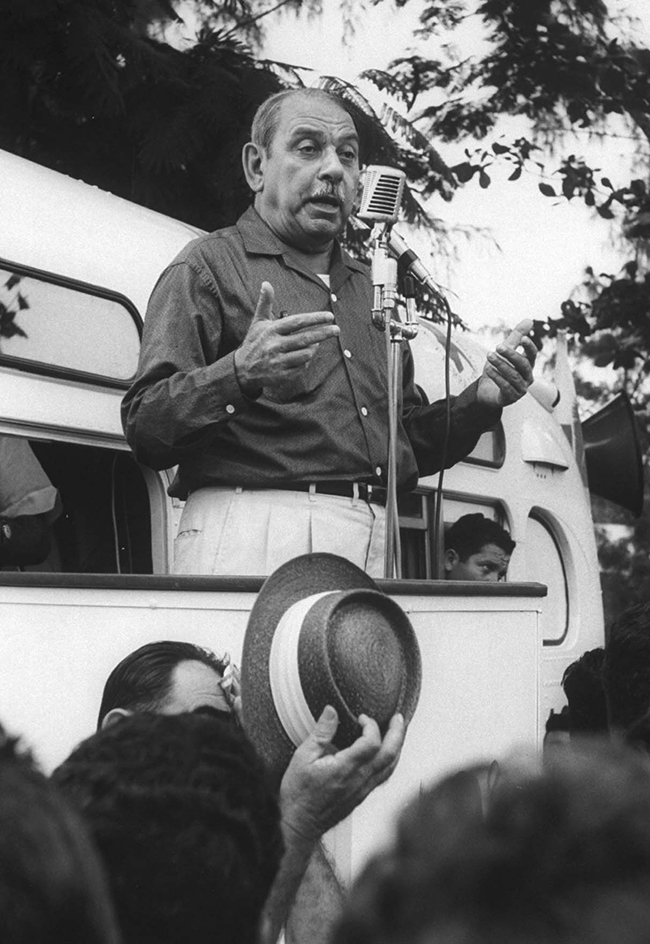
On July 25, 1946, President Harry S. Truman appointed Jesús Toribio Piñero as the first island-born governor of Puerto Rico. In 1947, Congress expanded Puerto Rican self-government by permitting the islanders to elect their own governor. Luis Muñoz Marín was elected governor in 1948. His Popular Democratic Party favored a commonwealth linked to the United States.
In 1950, Congress passed Public Law 600, which gave Puerto Rico the power to write its own constitution. Puerto Ricans approved the law in a referendum (direct, popular vote) in 1951. A Puerto Rican convention then wrote a constitution modeled on that of the United States, and the Puerto Rican people approved it. The U.S. Congress approved the Constitution on July 1, 1952. On July 25, Puerto Rico became a self-governing commonwealth.
During the 1950’s, Puerto Rican migration to the U.S. mainland rose sharply. Thousands of islanders moved to New York City and other large mainland cities in search of jobs. Many could not speak English and had difficulty adjusting to their new life.
The late 1900’s.
Industry grew rapidly in Puerto Rico during the 1960’s and 1970’s. The Economic Development Administration, known in Spanish as Fomento, helped businesses establish thousands of factories. Industrial growth reduced unemployment. However, the unemployment rate remained significantly higher than the U.S. rate.
In 1964, Governor Muñoz Marín announced he would not run for a fifth term. Another Popular Democrat, Roberto Sánchez Vilella, became governor in 1965.
In 1967, Puerto Ricans voted to retain their commonwealth status rather than to become a U.S. state or an independent country.
In 1968, Luis A. Ferré of the New Progressive Party was elected governor. Ferré and his party favored statehood for Puerto Rico. He ran for reelection in 1972 and was defeated by Rafael Hernández Colón, the Popular Democratic Party candidate. In 1976, Carlos Romero Barceló of the New Progressive Party was elected governor. He was reelected in 1980. He ran for a third term in 1984, but he was defeated by Hernández Colón. Hernández Colón was reelected in 1988. In 1992, Pedro J. Rosselló of the New Progressive Party was elected governor. He was reelected in 1996.
The early 2000’s.
Sila María Calderón of the Popular Democratic Party (PPD) became Puerto Rico’s first woman governor in 2001. She served until 2005.
In 1941, the U.S. Navy had begun conducting military training activities, including bombing exercises, on the Puerto Rican island of Vieques. Many Puerto Ricans opposed the Navy’s presence and activities there. In 1999, a civilian security guard was killed in a bombing accident. Public protests then broke out and continued for more than a year. The Navy officially ended its use of the island in 2003.
In 2004, Puerto Ricans voted again for governor. The U.S. District Court for Puerto Rico and the Puerto Rico Supreme Court ordered a recount of the ballots, because the results were extremely close. The island’s elections commission eventually declared Aníbal Acevedo Vilá of the Popular Democratic Party governor. His main opponent was former Governor Pedro Rosselló.
In 2006, a shortage of public funds caused government offices and schools to shut down for two weeks. Thousands of people were left without work. The financial crisis was brought about in part by the inability of the governor and the legislature to agree on a budget. The government then enacted the island’s first sales tax to generate revenues.
In 2008, Governor Acevedo Vilá and some of his associates were charged with crimes related to campaign finance during the early 2000’s. The crimes allegedly were committed during Acevedo Vilá’s campaigns to become Puerto Rico’s resident commissioner in the U.S. Congress and governor. Acevedo Vilá denied any wrongdoing. In November, Luis G. Fortuño, who had been Puerto Rico’s resident commissioner since 2005, defeated Acevedo Vilá in the election for governor. Acevedo Vilá was found not guilty of all corruption charges in 2009. In 2012, Alejandro García Padilla of the PPD was elected to succeed Fortuño as governor.
In 2015, Puerto Rico’s government declared that it could not pay its debt of more than $70 billion. The U.S. Congress passed a law in 2016 creating a financial oversight board to temporarily manage Puerto Rico’s finances and reorganize its debt. Also in 2016, New Progressive Party (PNP) candidate Ricardo Rosselló, the son of Pedro Rosselló, was elected governor. Puerto Rico entered a legal status similar to bankruptcy in 2017. Technically, as a U.S. territory, it was not allowed to declare actual bankruptcy.
Also in 2017, Hurricanes Irma and Maria struck Puerto Rico, knocking out electric power throughout the island and causing widespread damage. Maria was particularly destructive, and the island struggled to rebuild. The hurricanes killed about 3,000 people. 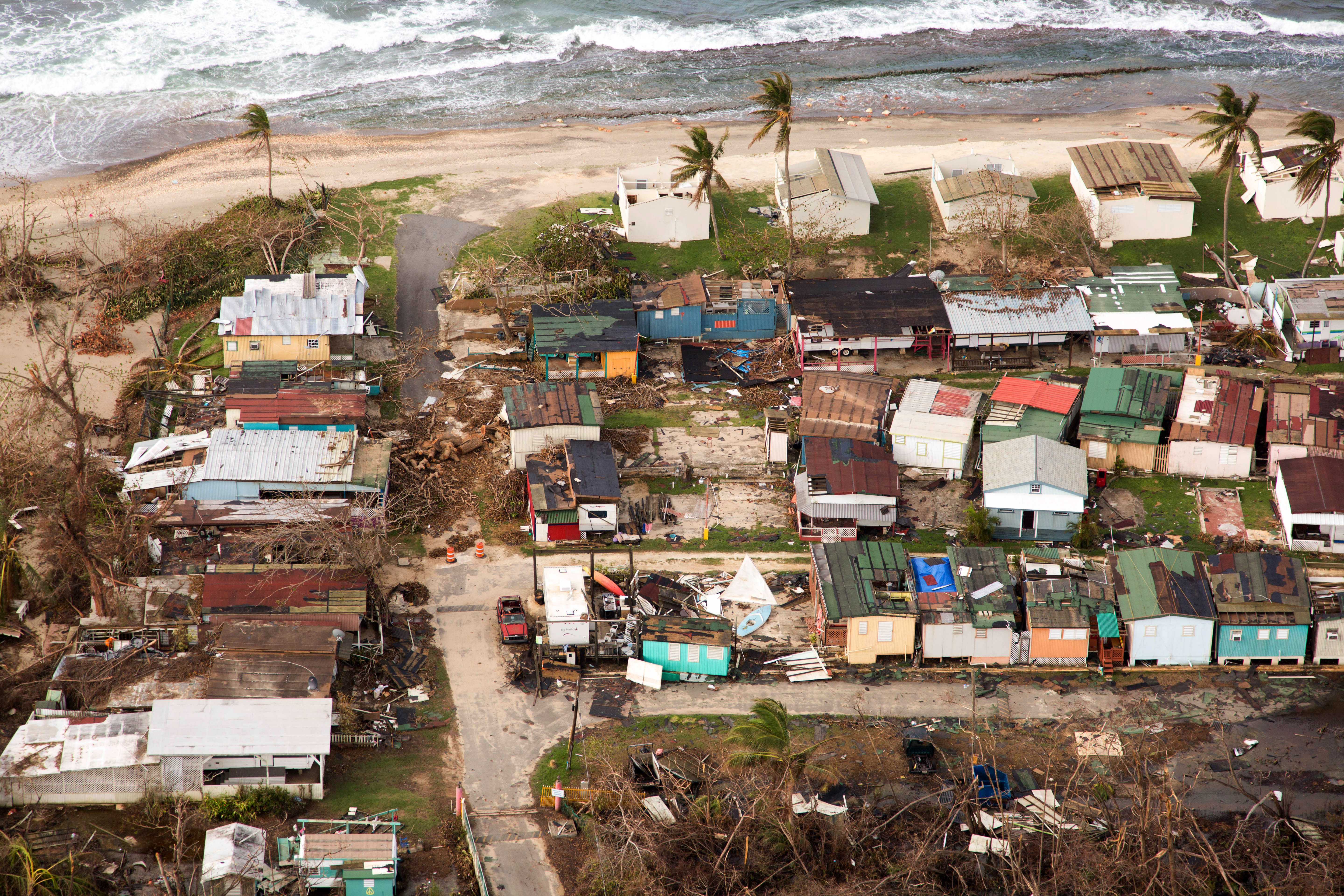
Mass demonstrations broke out in Puerto Rico in 2019 after offensive private messages between Governor Rosselló and his associates were made public. Other public complaints included the poor economy, political corruption, and the government response to Hurricane Maria. Rosselló resigned. After a legal controversy over succession, Wanda Vázquez Garced, the secretary of justice, became governor.
In late 2019 and in 2020, a series of many earthquakes struck southwestern Puerto Rico, some causing heavy damage. More than a dozen of the earthquakes had a magnitude of 5 or higher. These included a magnitude 6.4 earthquake on Jan. 7, 2020.
Pedro Pierluisi of the PNP was elected governor in late 2020. He took office in early 2021. In 2022, Puerto Rico emerged from five years of what was essentially bankruptcy after a major debt-restructuring plan significantly reduced the amount it owed.
